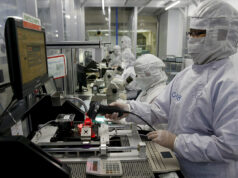Foreign projects seen to raise AC Energy’s capacity
AYALA-LED AC Energy, Inc. expects 70% of its target 1,000-megawatt (MW) installed renewable energy capacity by 2020 to come from its foreign projects, including its investments in Vietnam, Indonesia and Australia, its top official said.
“If you look at our renewables target… remember we’re targeting a thousand megawatts of renewables by 2020, I would expect around 70% of [that] to be international and 30% local,” Eric T. Francia, AC Energy president and chief executive officer, told reporters on Monday night during the annual meeting of the Confederation of Solar Developers of the Philippines.
“Right now we are around that — we are two-thirds [international and] one-third [local],” he said.
Mr. Francia said AC Energy’s renewable energy capacity in Indonesia is currently bigger than that of the Philippines because of its acquisition of an existing geothermal project in the former.
In April last year, AC Energy and its joint venture partners completed the acquisition of Chevron Corp.’s geothermal assets and operations in Indonesia, further boosting AC Energy’s renewable energy portfolio in that country after earlier investing in a wind farm.
The Chevron deal gave AC Energy a 19.8% stake in the 637-MW geothermal steam and power capacity in Darajat and Salak geothermal fields along with its 75% stake in the 75-MW wind farm project in Sidrap, South Sulawesi. These acquisitions more than doubled the company’s clean energy capacity to at least 264 MW.
“We’re going to add Vietnam soon. We already have 30 [MW] but in the next few weeks, we do expect to reach financial close for solar in Vietnam,” he said.
In January, AC Energy announced a partnership with Vietnam’s BIM Group to develop more than 300 MW of solar power in that country. They broke ground on a 30-MW solar project valued at 800 billion Vietnamese or P1.8 billion.
Mr. Francia said in the coming weeks, the company would “make a lot of progress” in adding to the existing solar capacity in Vietnam ahead of its feed-in-tariff deadline.
“If you add Vietnam, and hopefully Australia will follow suit next year in terms of financial close, we can really see those international numbers moving up, but we’re not gonna be totally silent here in the Philippines. We’re still hopeful that we can do a few hundred megawatts,” he said.
In May, AC Energy said it was investing $230 million to acquire a 50% stake in the Australian business of UPC Renewables and provide funding for the latter’s renewable energy projects.
AC Energy, a subsidiary of Ayala Corp., said its entry into the Australian renewables market is through a joint venture with the international renewable energy developer. It said UPC Renewables Australia complements AC Energy’s goal to exceed 5,000 MW by 2025. The foreign energy platform is focused on large scale projects, it said.
AC Energy said UPC Renewables Australia is developing the 1,000-MW Robbins Island and Jims Plain projects in North West Tasmania, and the 600-MW New England Solar Farm near Uralla in New South Wales.
Mr. Francia said the company’s ongoing local coal-fired power plant projects would continue, including the construction of the 552-MW clean pulverized coal-fired power generation facility under subsidiary GNPower Kauswagan Ltd. Co.
AC Energy targets to develop by 2020 up to 2,000 MW of capacity, of which 1,000 MW is targeted to come from renewable energy.
In the Philippines, the company has a 20% stake in the 632-MW GNPower Mariveles Coal Plant Ltd. Co.; 50% in the 668-MW GNPower Dinginin Ltd. Co.; 35% in the 244-MW South Luzon Thermal Energy Corp.; and 85% in GNPower Kauswagan. It is looking for interested partners in these coal-fired power plants. — Victor V. Saulon



